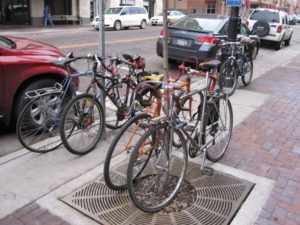 As cities across the U.S. are battling it out for the distinction of “Most Bike-Friendly,” does Duluth stand a chance of being included some day in the Top-50 list?
As cities across the U.S. are battling it out for the distinction of “Most Bike-Friendly,” does Duluth stand a chance of being included some day in the Top-50 list?
You might think that our long winters and steep hills would prevent this. But think again: two of the top-ranked cities, Portland, Oregon (back to #1 this year) and Minneapolis (dropped to #2) are neither sunny nor warm places for much of the year-Portland is rainy , cool and hilly and we know all about the cold and snowy winters of Minnesota.
Consider also that two other cities – Boulder, Colorado (#3), which is comparable to Duluth in its total population and San Francisco, California (#8) – feature many or more of the same topographical obstacles we face here.
So what does it take to get on this list?
In addition to having a significant interest in cycling on the part of its residents, a city needs to be willing to be proactive and try new things.
In some ways Duluth has operated this way, to promote bicycling as a transportation option. For example,
- The DTA was an early adopter of the bike racks on the front of buses.
- There is a dedicated lane on Park Point (from April to October) for non-motorized users.The Bong Bridge (U.S. Hwy 2/53) connecting Duluth and Superior includes a separate, protected bicycle and pedestrian lane.
- The City of Duluth and St. Louis County are creating space for bicyclists and pedestrians by adding shoulders where possible when reconstructing streets, including on parts of Arrowhead Road, Wallace Avenue, Snively Road and the new space created on Glenwood Street.
- The Lakewalk (and the future Cross City Trail link that will connect the Lakewalk to the Munger Trail) is a bike-friendly, off-street link that will run the entire length of Duluth.
These are highly visible bike-friendly amenities. However, what is missing is just as noticeable:
- Roads commonly labeled by local bicyclists as unsafe or dangerous—Superior Street in Downtown Duluth, Woodland Avenue around UMD, and 4th Street near the hospitals —are the very streets that should be the most accommodating. Although these major streets carry a quite a bit of car traffic, they are also ideal for bicycling, as they provide the most direct route to major destinations and generally have less severe slopes than other streets.
- Other streets and public spaces, including intersections and routes on top of the hill near the Mall where bicycling has not been given a whole lot of thought, are enormous impediments to bicycling in this region.
But we also have some opportunities in our near future for the Twin Ports community to be proactive in a couple of upcoming projects:
- Belknap Street, in the City of Superior, is being considered for some type of bicycle accommodation that would complement the planned bike lanes on Tower Avenue as part of their downtown streetscape project.
- A big opportunity in Duluth is the new DTA Multimodal Transportation Terminal, a part of which is a new “northwest passage” skyway connecting Downtown Duluth and the DECC. This facility has the opportunity to serve as a bike station as well as provide a safe and convenient bicycle path across I-35 to and from the core downtown area.
So, what do you think? What’s your experience with biking in Duluth? Do we have the commitment that’s necessary to bring our city up to the level of one of America’s most bike-friendly cities? What do you see as opportunities—or opportunities lost—for improving biking here?







